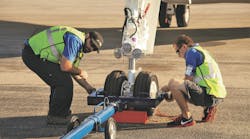FLIGHT SAFETY
ATD-200 gives pilots another pair of eyes
By Jordanna Smida, Associate Editor
October 2000
As more near and midair collisions find a slot on the nightly news, Monroy Aerospace has developed a new air traffic detection device to aide pilots flying in VFR conditions.
Monroy Aerospace, based in Coral Springs,
FL, began its business in 1996 conducting the long range upgrade for the
various Mooney airplanes.
Jose Monroy, president of Monroy Aerospace
and a pilot of 25 years, recognized a need in the general aviation industry
for a low-cost traffic alert device after experiencing a few close encounters
with aircraft.
Monroy set out to develop the ATD-200,
a traffic alert device targeting piston-engine aircraft. The ATD-200 is
portable and detects all transponder-type replies from nearby aircraft.
The proximity of the aircraft are indicated on a bright LED display and,
simultaneously, a voice provides voice alerts in relation to traffic proximity.
A Mode-S indicator also indicates if the traffic may be TCAS equipped.
The device can be plugged into a cigarette lighter and the headphone jack.
If one light illluminates, there’s
an aircraft within four miles of the pilot’s aircraft. If all five
are lit, it’s within a half mile.
The catalyst for this project, according
to Monroy, was the fact that many of the piston-engine segment of general
aviation fly in VFR conditions with no IFR flight plan.
Monroy says he has found in reviewing midair
accident reports that many of the collisions have been in VFR conditions
where visibility was good. "When you look at the way airplanes were
approaching each other, the pilots could have seen each other if they
had looked out the window and avoided collision. We needed something to
alarm pilots."
"In that mode of operation you don’t
receive the ATC traffic advisory. You need to have something that will
provide the pilot with an alert of the traffic that is around you,"
he says.
The ATD-200 is also compatible with existing
transponder technology in aircraft, including Mode-S, Mode-A and Mode-C
type transponders, which, according to Monroy, "is what you want
to give you the most protection for the most aircraft that are in the
area."
The ATD-200 usually won’t detect transponders
in an area with no ground radar stations. However, in areas with no ground
stations, the device can still detect transponder-emitting aircraft Monroy
says, "We have found that even though you might be in an area with
no ground radar stations, the transponders can be interrogated by airborne
TCAS-equipped airplanes, and in that case it will reply to those airplanes."
Dollars and Sense
Greg Brown, private pilot, instructor, and
this year’s FAA/Industry National Flight Instructor of the Year,
began investigating collision avoidance technology after an incident at
his base airport. He found the least expensive equipment that can be installed
in an aircraft would cost around $5,000. He discovered Monroy’s ATD-200
for $789. "While that’s not inexpensive, once you’re nervous
about collision it’s affordable," he says. "The most amazing
thing about this product is that no one knows about it... Once you get
a scare, then anything in your budget seems reasonable."
Husband and wife private pilots Larry and
Susan Collins also opted to purchase the ATD-200 after a close encounter
with another aircraft. "How much is your life worth?" Larry
asks. "It had a 30-day money-back guarantee and the next price was
$6 to $7 thousand," he says.
Learning Curve
Brown, who notes that the ATD-200 is another
set of eyes for pilots, says there is also a learning curve with the device.
"It’s very frustrating because you often don’t see aircraft
to begin with, but it does get you looking out the window."
Jim Hackman, a pilot and the southwest representative
for Cessna Pilot Centers, elected to purchase the ATD-200 and also found
there to be a learning curve in using it.
"You need to know what it’s telling
you... You see a lot of airline traffic high above you that does not trip
the device," he says.
Though it takes some getting used to, the
device has been a good investment, say the Collins. "There have been
times where we have seen airplanes that I know we wouldn’t have seen.
If it goes off, there’s an airplane within 4 miles. If its’
an airliner it might go off sooner because they have stronger transponders,"
he explains.
"It wakes you up and reminds you to
look out the window. Anyone who is flying and has an airplane within four
miles needs to know that." Larry says.
Susan adds, " If you are in an area
of high traffic you have the option of muting the audio and, by the lights,
you can tell quickly what’s out in the distance without having the
audio."
She also indicates that the ATD-200 could
be a useful tool for flight instructors. "It’s portable,"
she says, "and their attention is diverted to what the student is
doing."
The ATD-200 can also be used in helicopter
operations in VFR conditions, such as news crews or police, Monroy says.
NEW ADDITIONS TO COME
Monroy Aerospace has plans in the works
for other products similar to the ATD-200 which would include a bearing
capability. Monroy says the challenge will be to make it portable.
For information on the ATD-200, contact
Monroy Aerospace at www.monroyaero.com
or call (954) 294-9006.
ATD-200 SPECIFICATIONS
Frequency: 1086-1094 Mhz
Signal format: Mode A,C,S
MTL: -60 dBm
Range Accuracy:
20% with ext ant. @+53
dBM traffic power
MRR: 250 r/s
Suppression Range:
-15 dBM to +20 dBM
Maximum Signal Input:
+23 dBM
Antenna Impedance: 50 Ohms
Antenna Connector:BNC
Audio Output Power:
2 Watts @ 8 Ohms
Speaker Output: 8 Ohms
Phone Output: 600 Ohms
Message Rep. Rate:
Every 10 sec.
Supply Voltage:
+11 VDC to +30 VDC
Supply Current: 0.2 Amps
Operating Temperature:
-20 C to + 55 C
Operating Altitude:
-1000 ft to 25,000 ft
Enclosure Type:
Extruded Aluminum
Unit Weight: 10 ounces
Unit Dimensions:
2.75" W x 0.75" H
x 5.0" D
Installation Depth: 6.5 inches




